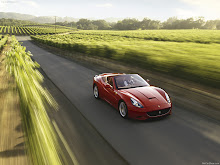Saturn's two unique cars are the Astra and Vue. The Astra is a very good car, but hasn't done well here. The new Saturn Vue however is a different story. The new Vue has sold fairly well. Over Christmas we rented a Saturn Vue XR AWD with a 252hp 3.6L V6. Our Vue had 29,000 miles on it and being a rental car, it was of course in worse condition than an average family car with 30,000.
One of the things Saturn wanted from the Vue was a "European feel". That's term that's tossed around a lot, but the American car companies are very concerned about achieving. The reason for that is cars like the Buick Century (Or any Buick made since the 1980's), Cadillac Seville, Cadillac Deville, or something like the Ford Taurus all were terrible to drive. They had floaty ride quality and steering that did nothing to decide what direction the car went. The sales of those cars got worse as the European cars gained in popularity. So when GM was making the Vue they wanted the comfortable, but yet firm and responsive ride and steering that European cars have mastered. Overall the Vue is good at those. The ride certainly isn't soft, in fact it's almost too firm at times, but no where near as bad as the BMW X3, which feels like BMW simply forget to put a suspension in. The steering is responsive, but a little light.
The front of the Vue is a nice place to be. The seats are extremely comfortable once you get them into the right position. Quality was usually a problem with Saturn's, but the Vue feels well made, despite the dashboard looking rather flimsy. The rental we drove did have 29,000 miles on it though and that's rental miles, so the car had held up well. Old Saturn's were made of plastic, which was cheap to make and repair, but was a big safety problem and forced all the cars to be boring looking boxes. With the new Vue the metal body allowed lots of curves and creases that make for a very good looking car. The metal also allowed it to be a Top Safety Pick in the IIHS crash tests.
So far the Vue sounds pretty good, but it has a few huge problems. The biggest it weight, it practically ruins this car. The Vue weighs 4300 pounds, which means even the 252hp 3.6L V6 delivers underwhelming performance, 0-60 mph is nearly 8 seconds and with the smaller V6 and four cylinder versions it takes longer than almost any other small SUV. Fuel economy is another area ruined by weight, as well as the handling. The Vue's exterior dimensions are larger than the Honda CR-V, Hyundai Santa Fe, Subaru Forester and Toyota RAV4, but the cargo area is much smaller. The back seat is also too small and too hard. The Vue is also about $2,000 to expensive, but GM never sells a car for its list price, so that can be fixed easily.
I really wanted to like the Vue and give it a good review, but I was a bit disappointed. The Vue is a very good car, but compared to the Honda CR-V, Hyundai Santa Fe, Nissan Rogue, Subaru Forester, or Toyota RAV4 it simply isn't good enough. It does however beat the Volkswagen Tiguan and Mitsubishi Outlander. There is a new Chevy Equinox coming out soon that's based off the Vue, so maybe that will work better.
